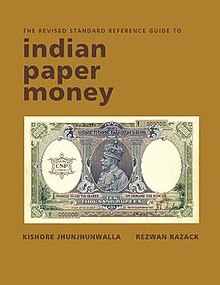The Revised Standard Reference Guide to Indian Paper Moneyis a 2012 book byRezwan RazackandKishore Jhunjhunwalla.[1][2]The book is a comprehensive compilation of facts, milestones, and other details regardingpaper moneyin India. It was published in India by Coins & Currencies.Kishore JhunjhunwallaandRezwan Razackare avid collectors of Indian currency.[3][4]The book traces the evolution of Indian currency dating back to 1770. It captures the various nuances of modern-day currency as well as incidents that helped shape this sector over the years.[5]The book is in its second edition—the first was authored by Jhunjhunwalla, whose collection was later purchased byRezwan Razack.The revised edition was published after 10 years of research. The book was introduced to the public by Uma Shankar, Regional Director of theReserve Bank of Indiaon 13 January 2012.[6]
 | |
| Author | Rezwan Razack&Kishore Jhunjhunwalla |
|---|---|
| Illustrator | Amkaysweb |
| Cover artist | Propel |
| Language | English |
| Subject | Numismatics |
| Publisher | Coins & Currencies |
Publication date | 2012 |
| Publication place | India |
| Media type | Print, hardbound |
| Pages | 626 |
| ISBN | 978-81-89752-15-6 |
Summary
editThe Revised Standard Reference Guide to Indian Paper Money’’ includes high resolution colour images of notes from Semi-Government and Presidency Banks, which functioned until 1861. The Government of India (British Raj) then undertook the issue of banknotes in 1861, and that is when all Early, Private, and Presidency Banks’ currency issues ceased. The Government of India issued banknotes in 1861 which wereunifacewith a portrait ofQueen Victoria,and underprinting was introduced to the portrait in the series beginning 1867.[6]
Vignettes in the book include the history of Indian bank notes dating back to 1770, when the Bank of Hindostan, a private bank located inCalcuttaissued its first banknotes. However, the earliest banknote to still survive is dated 1810, by theBank of Bengal.The book includes a comprehensive listing of all Indian banknotes since 1770.[6]Early on, all paper currency of India was printed by the Bank of England and shipped to India for distribution. The British India banknotes of King George V were also printed in England. In 1928, the India Security Press at Nasik became functional and took over from theBank of EnglandPress the printing of notes. In 1935, theReserve Bank of Indiawas established, and since then it has been the only currency-issuing authority and monetary agency for India. The King George VI Portrait Series were in circulation from 1936 till 1947. The series of KingGeorge Vand KingGeorge VIwere also overprinted for use inBurma.The overprinted banknotes of King George VI were also used inPakistanuntil 1948.[6]
The book also deals with banknotes since Indian independence, up to the current series of banknotes with the portrait ofMahatma Gandhi.These include the special-issue notes intended for use in the Persian Gulf for the Trucial States, as well as money used by theHajjpilgrims.[6]
The Osmaniabanknotes of Hyderabadof 1919-1953 also form a part of this book. Also listed are the issue of banknotes byJammu and Kashmirand the Hawala notes ofSaurashtra.The scope of this book includes the issues of Indo-Portuguese notes for Goa and Indo-French territories at Pondicherry. The cash coupons ofIndian Princely Statesthat were printed on paper were issued to counteract the shortage of metal duringWorld War II.The Prisoner of War coupons used as money by the interned prisoners of the Anglo-Boer War of 1899-1902, World War II, and theIndo-Pakistani War of 1971are also illustrated.[6]
The book has an entire chapter on Essays, Patterns, Proofs and Trials, which displays many of the best Indian banknotes that were designed but never made it into circulation.[6]
The book illustrates the watermarks and explains the minute features of the notes in detail.
Authors
editThe book has been primarily authored byRezwan Razack,the joint managing director of Prestige Groups,[7]in association withKishore Jhunjhunwalla,the sole author of the original ‘’The Standard Reference Guide to Indian Paper Money’’. The authors of the book also acknowledged the roles of Rekha Chandrabhanu, Bazil Shaikh, Murali Thantry, Sanjay Mittal, Mahalingeshwar Athani and Amarbir Singh, an expert on the banknotes and coins of theNizam of Hyderabad.[8]The Hyderabad notes are also known asOsmaniaSicca notes. The authors have dedicated a websiteindianbanknotes.comto keep the scholars and collectors up to date on Indian Banknote research.
References
edit- ^"Coins, currency expo in city from today".The Times of India.Archived fromthe originalon 14 July 2012.Retrieved30 March2012.
- ^"It will be a feast for numismatists".The Hindu.Retrieved30 March2012.
- ^Gargi Gupta."Meet India's biggest collector of banknotes".Rediff.Retrieved30 March2012.
- ^Gargi Gupta."Showing us the money".Business Standard.Retrieved30 March2012.
- ^"Show me the money".Express Buzz.Retrieved30 March2012.
- ^abcdefgStaff Reporter."Money talks, and how!".The Hindu.Retrieved30 March2012.
- ^"City builders bag awards".The Hindu.2005-11-26. Archived fromthe originalon 10 December 2005.Retrieved28 March2012.
- ^IBN LIVE."Show me the money".CNN -IBN. Archived fromthe originalon 31 January 2012.Retrieved28 March2012.
Book and Cover Designer
editDevika Thukral, Propel Design [1]- designers for the book